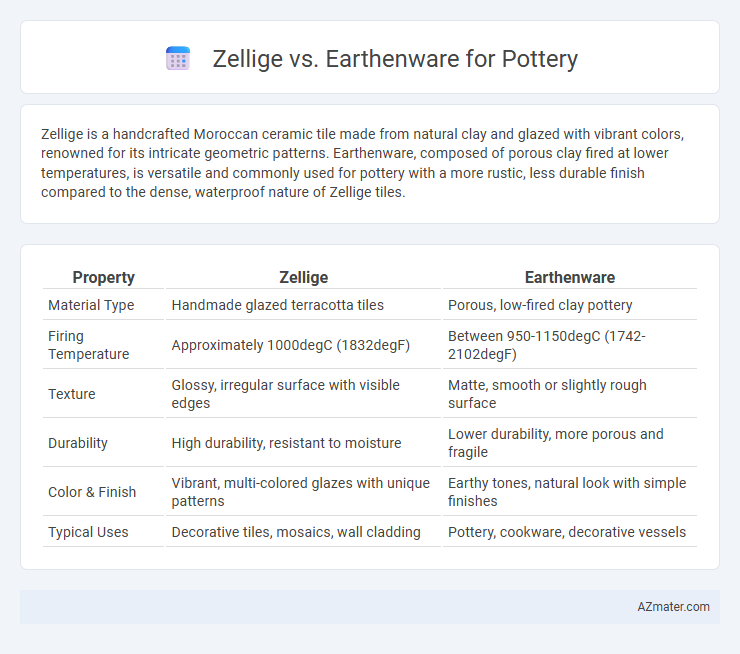Zellige is a handcrafted Moroccan ceramic tile made from natural clay and glazed with vibrant colors, renowned for its intricate geometric patterns. Earthenware, composed of porous clay fired at lower temperatures, is versatile and commonly used for pottery with a more rustic, less durable finish compared to the dense, waterproof nature of Zellige tiles.
Table of Comparison
| Property | Zellige | Earthenware |
|---|---|---|
| Material Type | Handmade glazed terracotta tiles | Porous, low-fired clay pottery |
| Firing Temperature | Approximately 1000degC (1832degF) | Between 950-1150degC (1742-2102degF) |
| Texture | Glossy, irregular surface with visible edges | Matte, smooth or slightly rough surface |
| Durability | High durability, resistant to moisture | Lower durability, more porous and fragile |
| Color & Finish | Vibrant, multi-colored glazes with unique patterns | Earthy tones, natural look with simple finishes |
| Typical Uses | Decorative tiles, mosaics, wall cladding | Pottery, cookware, decorative vessels |
Introduction to Zellige and Earthenware Pottery
Zellige is a traditional Moroccan mosaic tilework made from individually chiseled terra cotta tiles glazed in vibrant colors, known for its intricate geometric patterns and glossy finish. Earthenware pottery, on the other hand, is a porous ceramic fired at lower temperatures, resulting in a more rustic, matte surface suitable for functional and decorative uses. Both materials reflect distinct cultural aesthetics and manufacturing processes, with zellige emphasizing ornamental artistry and earthenware focusing on everyday utility.
Historical Origins of Zellige and Earthenware
Zellige pottery traces its origins to 10th-century Morocco, characterized by intricate geometric mosaic tiles crafted from terracotta clay and glazed in vibrant hues, reflecting Islamic art traditions. Earthenware, dating back to prehistoric times globally, consists of porous clay fired at low temperatures, making it accessible and widely used for everyday pottery across various ancient cultures. The historical roots of Zellige emphasize decorative artistry and cultural symbolism, while earthenware's origin highlights functional pottery for daily use.
Material Composition: Zellige vs Earthenware
Zellige is crafted using natural clay sourced from Moroccan regions, often combined with various mineral-based pigments, and fired at high temperatures to achieve its characteristic hardness and vibrant color palette. Earthenware, on the other hand, is composed mainly of porous clay mixtures that include iron and other metallic oxides, fired at lower temperatures, resulting in a more porous and less durable finish. The mineral content and firing process distinctly influence Zellige's durability and glossy surface compared to the more porous, matte texture typical of earthenware pottery.
Crafting Techniques Compared
Zellige pottery features intricate hand-cut tile mosaics made from individually shaped terracotta pieces, emphasizing geometric precision and the traditional Moroccan zellij technique. Earthenware pottery involves molding and firing clay at lower temperatures, allowing for diverse forms and surface treatments with simpler hand-building or wheel-throwing methods. The craftsmanship of Zellige prioritizes tile assembly and glaze application, while earthenware focuses on shaping versatility and varied decorative finishes.
Surface Texture & Aesthetic Differences
Zellige tiles exhibit a glossy, irregularly chiseled surface texture that creates shimmering light reflections, ideal for intricate geometric patterns in Moroccan architecture. Earthenware pottery features a matte, porous surface with natural, tactile imperfections, emphasizing rustic and organic aesthetics suited for functional ware. The contrasting textures of Zellige's glazed, reflective finish and Earthenware's unglazed, earthy look define their distinct artistic and cultural expressions in ceramic art.
Durability and Functional Properties
Zellige tiles, made from fired clay and glazed with vibrant colors, exhibit high durability and resistance to moisture, making them ideal for decorative and functional applications in kitchens and bathrooms. Earthenware pottery, while more porous and less durable than Zellige, offers versatility and ease of shaping but requires sealing to enhance water resistance and longevity. The superior hardness and glazing of Zellige contribute to its enhanced durability and functional utility compared to the more fragile, unglazed or lightly glazed earthenware.
Common Uses in Modern Pottery
Zellige tiles are primarily used for intricate wall and floor designs in modern pottery, celebrated for their vibrant colors and geometric patterns originating from Moroccan craftsmanship. Earthenware, known for its porous nature and versatility, is widely used for functional items such as plates, vases, and decorative pottery, often glazed to enhance durability. Both materials serve distinct aesthetic and practical purposes in contemporary ceramic art, with Zellige emphasizing ornamental appeal and Earthenware focusing on everyday usability.
Maintenance and Care Guidelines
Zellige tiles require regular sealing to prevent water absorption and staining, with cleaning recommended using mild soap and a soft cloth to maintain their intricate glaze and vibrant colors. Earthenware pottery is more porous and delicate, needing gentle hand-washing without harsh detergents, and should be kept dry to avoid cracking or mold growth. Both materials benefit from avoiding extreme temperature changes to preserve structural integrity and aesthetic appeal.
Environmental Impact and Sustainability
Zellige pottery, crafted from natural clay and glazed with mineral-based pigments, offers a highly sustainable option due to its use of locally sourced materials and low-energy traditional kiln firing processes. Earthenware, made from porous clay fired at lower temperatures, requires less energy but often involves glazing chemicals that may impact the environment negatively if not sourced responsibly. Both crafts emphasize eco-friendly production, but Zellige's long-lasting durability and natural materials generally result in a lower carbon footprint and enhanced environmental benefits.
Choosing Between Zellige and Earthenware
Choosing between Zellige and Earthenware for pottery requires understanding their distinct materials and aesthetic qualities; Zellige is a traditional Moroccan glazed tile known for its intricate geometric patterns and glossy finish, ideal for decorative surfaces. Earthenware offers a porous, rustic texture, made from natural clay fired at lower temperatures, suitable for functional pottery like bowls and plates. Consider Zellige for vibrant, durable decorative pieces, while Earthenware fits practical uses needing absorbency and a handcrafted feel.

Infographic: Zellige vs Earthenware for Pottery
 azmater.com
azmater.com